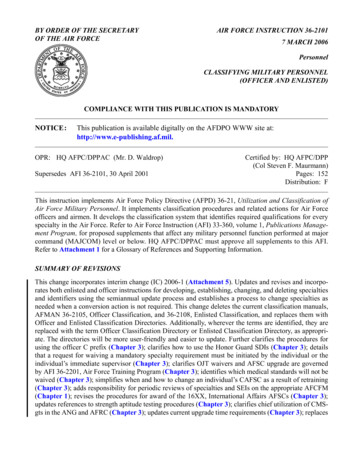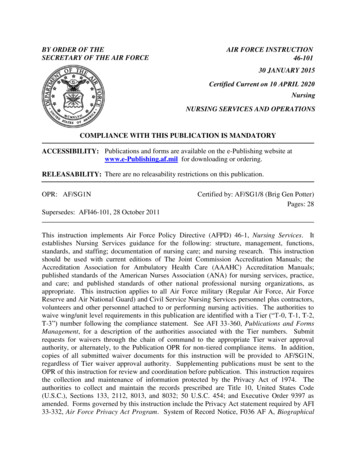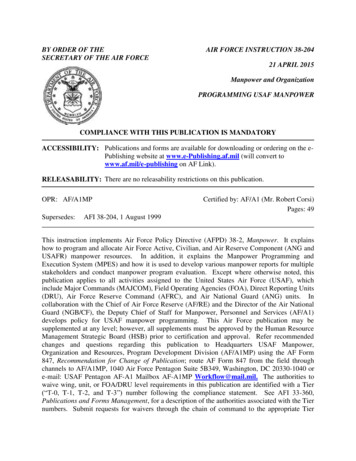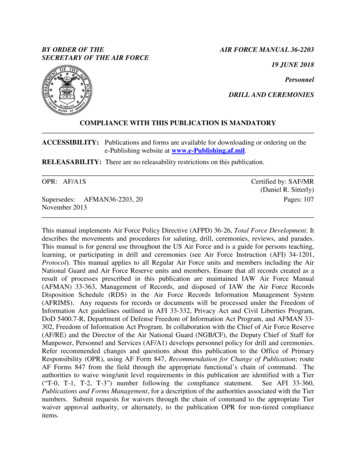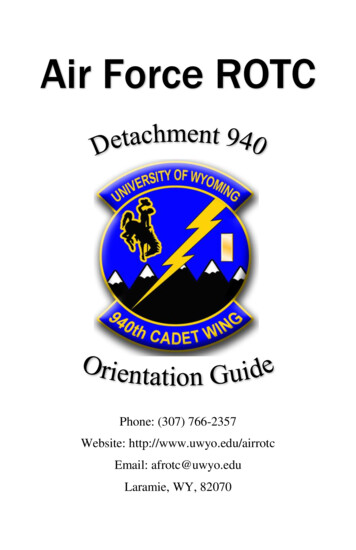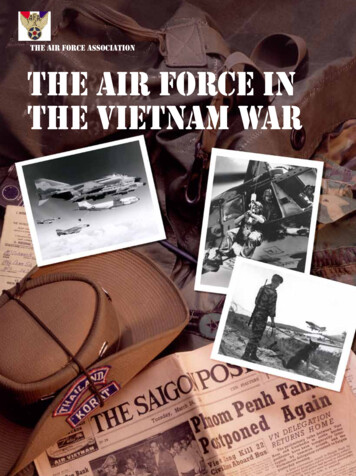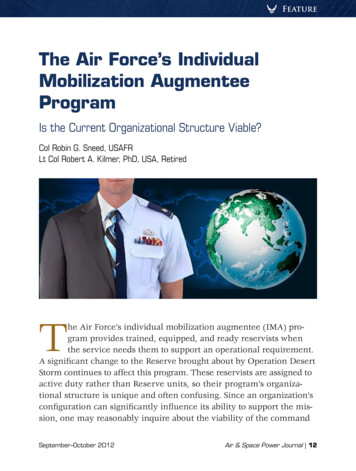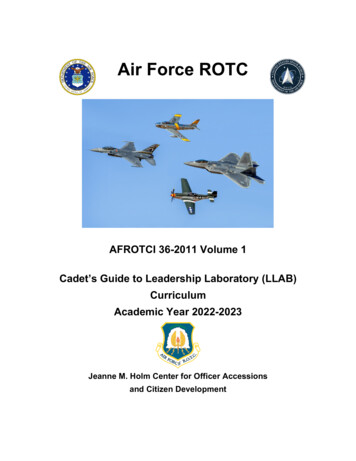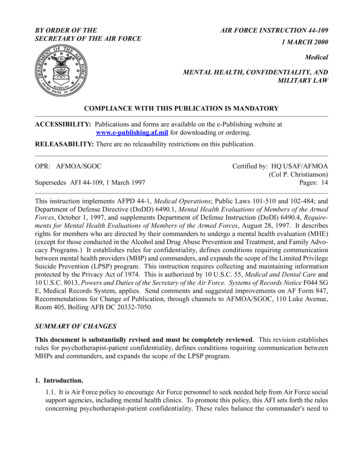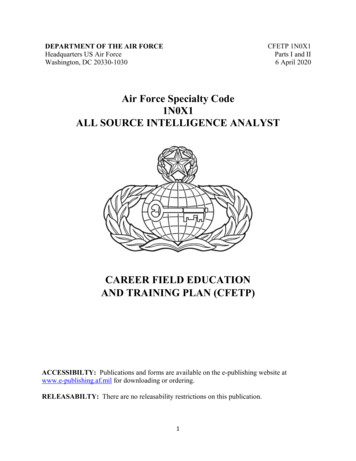
Transcription
CFETP 1N0X1Parts I and II6 April 2020DEPARTMENT OF THE AIR FORCEHeadquarters US Air ForceWashington, DC 20330-1030Air Force Specialty Code1N0X1ALL SOURCE INTELLIGENCE ANALYSTCAREER FIELD EDUCATIONAND TRAINING PLAN (CFETP)ACCESSIBILTY: Publications and forms are available on the e-publishing website atwww.e-publishing.af.mil for downloading or ordering.RELEASABILTY: There are no releasability restrictions on this publication.1
CAREER FIELD EDUCATION AND TRAINING PLANAll Source Intelligence AnalystAFSC 1N0X1Table of ContentsPART IPreface4Abbreviations/Terms Explained5Section A – General InformationPurpose of the CFETPUse of the CFETPCoordination and Approval of the CFETP10Section B – Career Progression and InformationSpecialty DescriptionSkill/Career ProgressionApprentice Level (3)Journeyman Level (5)Craftsman Level (7)Superintendent Level (9)Training DecisionsCommunity College of the Air ForceCareer Field Path12Section C – Skill Level Training RequirementsPurposeSpecialty QualificationsApprentice Level (3)Journeyman Level (5)Craftsman Level (7)Superintendent Level (9)25Section D – Resource Constraints29PART IISection A – Specialty Training Standards30Section B – Course Objective List422
Section C – Support Materials42Section D – Training Course Index42Section E – MAJCOM Unique Training44Summary of Changes: Line items have been revised to reflect changes in requirements. STSIntelligence Fundamental Core (Common Core) line items have been incorporated into the1N0X1 STS where applicable. Other changes include the addition of space and PubliclyAvailable Information (PAI) line items as well as the removal of 5 and 7 level time in trainingrequirements for active duty members.OPR: 315 TRS/XPCertified By: Acting AF/A26 Enlisted ISR CFM (SMSgt Breana Oliver)Supersedes: CFETP 1N0X1, 6 January 2020Number of Printed Pages: 453
All Source Intelligence AnalystAFSC 1N0X1CAREER FIELD EDUCATION AND TRAINING PLANPart IPreface1. This Career Field Education and Training Plan (CFETP) is a comprehensive education andtraining document that identifies life-cycle education/training requirements, training supportresources, and minimum core task requirements for this specialty. The CFETP will providepersonnel a clear career path to success and will instill rigor in all aspects of career field training.NOTE: Civilians occupying associated positions will use Part II to support duty positionqualification training.2. The CFETP consists of two parts; both parts of the plan are used by supervisors to plan,manage, and control training within the career field.2.1. Part I provides information necessary for overall management of the specialty. Section Aexplains how everyone will use the plan; Section B identifies career field progressioninformation, duties and responsibilities, training strategies, and career field path; Section Cassociates each level with specialty qualifications (knowledge, education, training, etc.); SectionD indicates resource constraints. Some examples are funds, manpower, equipment, facilities;Section E, when used, identifies transition training guide requirements.2.2. Part II includes the following: Section A identifies the Specialty Training Standard (STS) andincludes duties, tasks, technical references to support training, Air Education and TrainingCommand (AETC) conducted training, wartime course, core task, and correspondence courserequirements; Section B contains the course objective list and training standards supervisors willuse to determine if Airmen satisfied training requirements; Section C identifies available supportmaterials. An example is a Qualification Training Package (QTP), which may be developed tosupport proficiency training. These packages are identified in AFIND8, Numerical Index ofSpecialized Educational Training Publications; Section D identifies a training course indexsupervisors can use to determine resources available to support training. Included here are bothmandatory and optional courses; Section E identifies MAJCOM unique training requirementssupervisors can use to determine additional training required for the associated qualification needs.3. Using guidance provided in the CFETP will ensure individuals in this specialty receiveeffective and efficient training at the appropriate point in their career. This plan will enable us totrain today's work force for tomorrow's jobs. At unit level, supervisors and trainers will use PartII to identify, plan, and conduct training commensurate with the overall goals of this plan.4
ABBREVIATIONS/TERMS EXPLAINEDAdvanced Training (AT). Formal course which provides individuals who are qualified in oneor more positions of their Air Force Specialty (AFS) with additional skills/knowledge to enhancetheir expertise in the career field. Training is for selected career Airmen at the advanced level ofthe AFS.Air Force Career Field Manager (AFCFM). An individual on the Headquarters United StatesAF staff who is responsible for career development programs, functional management andutilization, specialty standards and requirements, training, and force management for a family ofAir Force Specialties (1NXXX). This includes identifying the task requirements and training foran AF specialty (AFS) or occupational series. This individual will review and/or approve allproposed changes to specialties within their career family.Air Force Job Qualification Standard (AFJQS). A comprehensive task list which describes aparticular job type or duty position. They are used by supervisors to document taskqualifications. The tasks on AFJQS/Command Job Qualification Standard are common to allpersons serving in the described duty position.Air Force Specialty (AFS). A group of duty positions that require common qualificationsidentified by a title and code.Air Force Specialty Code (AFSC). A combination of alpha-numeric characters which are usedto identify a specific career field and qualification level for Air Force officers and enlistedpersonnel.Career Development Program (CDP). The ISR CDP is an online, modular, semi-interactive,scenario-based training course for Airmen completing their 5-skill level upgrade.Career Field Education and Training Plan (CFETP). A CFETP is a comprehensive,multipurpose document encapsulating the entire spectrum of education and training for a careerfield. It outlines a logical growth plan that includes training resources and is designed to makecareer field training identifiable, to eliminate duplication, and to ensure this training is budgetdefensible.Career Training Guide (CTG). A document that uses Task Modules (TMs) in lieu of tasks todefine performance and training requirements for a career field.Chief Enlisted Manager (CEM). A five-digit code ending in “00” to identify CMSgt andCMSgt selectees as top enlisted managers in both highly technical skills and in broad areas ofmanagerial competence.Continuation Training. Additional training exceeding requirements with emphasis on presentor future duty assignments.5
Core Intelligence Training (CIT). Fundamental training across the 1NXXX Career Field.Core Task. A task AFCFMs identify as a minimum qualification requirement within an AirForce specialty or duty position. Core Tasks for the AFS can be either task- or knowledge-basedand are the STS line items fundamental to meeting these core competencies. Each MAJCOM isresponsible for developing the minimum standard to which each core task will be trained. Coretasks are common to all personnel within an AFS required to perform intelligence functions. Theskills (or knowledge) must be trained, maintained, and certified, regardless of dutyposition/location and are based upon skill level.Core Missions. The mission of the U.S. Air Force is to fly, fight and win in air, space andcyberspace. The following are the core missions according to the USAF Posture StatementFiscal Year 2019: 1. Air and Space Superiority 2. Intelligence, Surveillance, and Reconnaissance3. Rapid Global Mobility 4. Global Strike 5. Command and ControlCourse Objective List (COL). A publication, derived from initial/advanced skills coursetraining standard, identifying the tasks and knowledge requirements, and respective standardsprovided to achieve a 3-5-7-skill level in this career field. Supervisors use the COL to assist inconducting graduate evaluations in accordance with AFI 36-2651, Air Force Training Program.Deputy Career Field Manager (DCFM). An individual on HQ USAF staff, responsible to theAFCFM for overseeing all aspects of a particular AFS. Coordinates with MAJCOM functionaland training managers, technical training center personnel, and various Subject Matter Experts(SMEs) on career path development and identification of CFETP training task items to meetnational, tactical, and force training requirements. Other responsibilities include reviewing AFSmanpower utilization, managing AFS classification guidance, and overall status of the health oftheir particular AFS.Exportable Training. Additional training via computer assisted, paper text, interactive video,or other necessary means to supplement training.Field Evaluation Questionnaire (FEQ). An extensive survey based on the CFETP todetermine how well the formal training met the apprentice levels outlined in the CFETP. Thissurvey is sent approximately 6 months after graduation to the Base Education and TrainingManager, if unclassified, or direct to the unit training manager, if classified.Field Technical Training. Special or regular on-site training conducted by a field trainingdetachment (FTD), Formal Training Unit (FTU) or by a mobile training team (MTT).Initial Qualification Training (IQT). IQT is training needed to qualify intelligence personnelfor basic duties in an assigned position for a specific Mission Design Series (MDS), WeaponSystem, Intelligence function or activity without regard for a unit’s specific mission.Initial Skills Training. Skills received while attending a formal technical school that results inthe award of a 3-skill level in an AFSC.6
Instructional System Development (ISD). A deliberate and orderly, but flexible process forplanning, developing, implementing, and managing instructional systems. It ensures personnelare taught in a cost efficient way the knowledge, skills, and attitudes essential for successful jobperformance.Intelligence Occupational Badge. Air Force members are highly encouraged to wear theircurrent occupational badge on all uniform combinations. Wear the basic badge after completingtechnical school. Wear the senior badge after award of the 7-skill level, and wear the masterbadge as a Master Sergeant or above with five years in the specialty from award of the 7-skilllevel. For retrainees, credit toward new badges starts upon entry into the new AFSC.EXCEPTION: Chief Master Sergeants cross-flowed into a new CEM Code wear the basic badgeof their new career field upon award of the CEM Code, the senior badge after 12 months, and themaster badge after five years. Reference AFI 36-2903 for further guidance.MAJCOM Functional Manager (MFM). An individual at the MAJCOM/Joint activitycommand level who is responsible for identifying task and training requirements for an AFS orOccupational Series and is responsible for validating intelligence requirements, commandassignment entitlements, technical school graduate assignments and matching availablemanpower resources to meet the MAJCOM’s needs.Mission Qualification Training (MQT). MQT follows IQT and is training needed to qualifyintelligence personnel to perform their specific unit mission in an assigned mission position.Completion of Specialty Training Standard task and knowledge training requirements may beaccomplished concurrently with MQT.National Intelligence University (NIU). NIU is an accredited academic institution charted byCongress and the Joint Chiefs of Staff to prepare intelligence professionals for positions at Joint,Air Staff, and MAJCOM levels.Occupational Survey Report (OSR). A detailed report showing the results of an occupationalsurvey of tasks performed within a particular AFS.On-the-Job Training (OJT). Hands-on, over-the-shoulder training conducted to certifypersonnel in both upgrade (skill level award) and job qualification (duty position certification)training.Proficiency Training. Additional training, either in-residence or exportable advanced trainingcourses, or on-the-job training, provided to personnel to increase their skills and knowledgebeyond the minimum required for upgrade.Qualification Training (QT). Actual hands-on task performance training designed to qualify anindividual in a specific duty position. This portion of the dual channel on-the-job trainingprogram occurs both during and after the upgrade training process. It is designed to provide theperformance skills required to do the job.7
Qualification Training Package. An instructional package used at the unit to qualify, or aidqualification, in a duty position or program, or on a piece of equipment. It may be printed,computer-based, or in other audiovisual media.Reporting Identifier (RI). Identify authorizations and individual enlisted airmen who, for anyreason, are not identifiable in the classification structure.Resource Constraints. Resource deficiencies, such as money, facilities, time, manpower, andequipment that preclude desired training from being delivered.Skills Training. A formal course that results in the award of a skill level.Special Duty Identifier (SDI). Identify authorizations for enlisted airmen assigned to andperforming an actual group of tasks on a semi-permanent or permanent duty basis unrelated toany specific career field. Career Assistance Advisors, for example, are represented by the SDI8A100.Special Experience Identifier (SEIs). A three-character designator that identifies specificexperience or expertise within a particular career field. Established when experience or trainingis critical to a job. SEIs complement the assignment process but are not substitutes for AFSCs,CEM codes, prefixes, suffixes, SDIs, RIs, assignment instruction codes, and professionalspecialty course codes. Additionally, SEIs can serve as a tool for commanders to ensurepersonnel are placed/utilized correctly within an organization.Specialty Training Requirements Team (STRT)/Utilization & Training Workshop(U&TW). A forum co-chaired by the AFCFM and AETC Training Pipeline Manager comprisedof MAJCOM Functional Managers, Subject Matter Experts (SMEs), and AETC trainingpersonnel that determines education and training requirements and establishes the most effectivemix of formal and on-the-job training for each AFSC. The forum will create or revise trainingstandards, and set responsibilities for providing training. As a quality control tool, theSTRT/U&TW will be used to ensure the validity and viability of the AFS training thatdetermines career ladder training requirements.Specialty Training. A mix of formal training (technical school) and informal training (on-thejob) to qualify and upgrade Airmen in the award of a skill level.Specialty Training Standard (STS). An Air Force publication that describes skills andknowledge that Airmen in a particular AFS needs on the job. It further serves as a contractbetween AETC and the user to show the overall training requirements for an Air Force specialtycode that the formal schools teach.Standard. An exact value, a physical entity, or an abstract concept, established and defined byauthority, custom, or common consent to serve as a reference, model, or rule in measuringquantities or qualities, establishing practices or procedures, or evaluating results. A fixedquantity or quality.8
Supplemental Training. Formal training on equipment, methods, and technology not suited foron-the-job training and not included in AFS upgrade training.Training Planning Team (TPT). Comprised of the same personnel as a U&TW, however TPTsare more intimately involved in training development and the range of issues are greater thanthose normally covered in the U&TW forum.Upgrade Training (UGT). Mandatory training that leads to attainment of higher level ofproficiency.Wartime Skills. Wartime skills/tasks training are initiated based upon a national emergency.These wartime skills are identified by the letter “w” in the 3-level position of the STS and will betaught at an accelerated course at Goodfellow AFB while the trainee is going through technicaltraining school. NOTE: All tasks and knowledge items shown with a proficiency code in thisCFETP are trained during wartime.9
Section A - General Information1. Purpose. This CFETP provides information necessary for AFCFM, DCFMs, MFMs,commanders, training managers, supervisors and trainers to plan, develop, manage, and conductan effective career field training program. This plan outlines the training that individuals in thisAFS should receive in order to develop and progress throughout their career. This plan identifiesinitial skills, upgrade, qualification, advanced, and proficiency training. Initial skills training isthe AFS specific training an individual receives upon entry into the Air Force or upon retraininginto this specialty for award of the 3-skill level. Normally, this training is conducted by AETC atone of the technical training centers. Upgrade training identifies the mandatory courses, taskqualification requirements, and correspondence course completion requirements for award of the5-, 7- and 9-skill levels. Qualification training is actual hands-on task performance trainingdesigned to qualify an Airman in a specific duty position. This training program occurs bothduring and after the upgrade training process. It is designed to provide the performanceskills/knowledge required to do the job. Advanced training is formal specialty training used forselected Airmen. Proficiency training is additional training, either in-residence or exportableadvanced training courses, or on-the-job training provided to personnel to increase their skillsand knowledge beyond the minimum required for upgrade. This CFETP also serves thefollowing purposes:1.1. Serves as a management tool to plan, manage, conduct, and evaluate a career field-trainingprogram. Also, it is used to help supervisors identify training at the appropriate point in anindividual's career.1.2. Identifies task and knowledge training requirements for each skill level in the specialty andrecommends education/training throughout each phase of an individual's career.1.3. Lists training courses available in the specialty, identifies sources of training, and thetraining delivery method.1.4. Identifies major resource constraints, which impact, full implementation of the desiredcareer field training process.2. Uses. The plan will be used by MFMs and supervisors at all levels to ensure comprehensiveand cohesive training programs are available for each individual in the specialty.2.1. AETC training personnel will develop/revise formal resident, non-resident, field andexportable training based on requirements established by the users and documented in Part II ofthe CFETP. They will also work with the AFCFM and DCFM to develop acquisition strategiesfor obtaining resources needed to provide the identified training.2.2. MFMs will ensure their training programs complement the CFETP mandatory initial,upgrade, and proficiency requirements. Identified requirements can be satisfied by OJT, residenttraining, contract training, or exportable courses. MAJCOM-developed training to support thisAFSC must be identified for inclusion into this plan.10
2.3. Each individual will complete the mandatory training requirements specified in this plan.The lists of courses in Part II will be used as a reference to support training.2.4. Converting to New CFETP. Transcribing documentation to a new CFETP is anadministrative function, not a re-evaluation of training. Therefore, supervisor and trainer areconsidered synonymous for the purpose of documentation. Transcribe within 120 days (240days for ARC) of CFETP revision date or from date revision is posted to automated trainingrecords system. Upon publication of a new CFETP, use the following procedures to transcribe:2.4.1. Use the new CFETP to identify past and current training requirements and to transcribequalifications from the previous CFETP.2.4.2. For tasks previously qualified/certified and required in the current duty position, circle thesubparagraph number next to the task statement and enter the current date in the completioncolumn. Trainee initials in the trainee column and the current task certifier or supervisor/trainerinitials in the trainer column.2.4.3. For tasks previously certified but not required in the current duty position, transcribe onlythe previous certification date (no initials). If the task later becomes required in the dutyposition, recertify using current dates and initials.2.4.4. Annotate the AF Form 623a or automated version, (for example, “I certify the informationcontained in the CFETP dated XX was transcribed to the CFETP dated XX, and the trainee wasgiven the superseded CFETP.” Signed and dated by supervisor and trainee).2.5. An AFJQS may be used in lieu of Part II of the CFETP only upon approval of the AFCFM.NOTE: AFCFM may supplement these minimum documentation procedures as needed ordeemed necessary for their career field.3. Coordination and Approval. The AFCFM is the approval authority. The DCFM,MAJCOM representatives, and AETC training personnel will identify and coordinate on thecareer field training requirements. The AETC training manager for this specialty will initiate anannual review of this document by AETC and MFMs to ensure currency and accuracy. Usingthe list of courses in Part II, they will eliminate duplicate training.11
Section B - Career Progression and Information4. Specialty Description.4.1. Specialty Summary. Performs/manages intelligence activities/functions includingdiscovering, developing, evaluating, and providing intelligence information. Related DoDOccupational Subgroup: 124300.4.2. Duties and Responsibilities.4.2.1. Supports all aspects of Air Force operations by discovering, collating, analyzing,evaluating and disseminating intelligence information. Produces all-source intelligence,situation estimates, adversarial nation, terrorist, insurgent threat studies, and other intelligencereports and studies. Advises commanders on force protection and intelligence information forUS and Partner Nations. Conducts intelligence debriefings of US and allied military personnelinvolved in combat operations. Prepares mission reports.4.2.2. Conducts intelligence training. Instructs military personnel on collecting and reportingrequirements and procedures, recognition techniques, and assessing offensive and defensiveweapon system capabilities. Assists SERE (Survival Evasion Resistance and Escape) andAircrew Flight Equipment personnel in training personnel recovery and code of conduct, whennecessary. Collates intelligence and operations materials, and assembles final products formission briefing, study, and use.4.2.3. Produces intelligence materials. Prepares, maintains, and presents intelligence displays,reports and briefings. Discovers, compiles, evaluates, researches, analyzes, and disseminatesintelligence information. Establishes intelligence collection requirements. Identifies andestablishes unit requirements for intelligence reference materials and maintains intelligencereference files and automated intelligence databases. Uses intelligence automated data systemsto store, retrieve, display, and report intelligence information.4.2.4. Performs support to mission planning and execution. Provides tailored collectionsplanning, threat analysis, and intelligence expertise necessary to develop detailed mission plansfor air, space, cyberspace and special operations. Provides current situational awareness andIntelligence, Surveillance and Reconnaissance (ISR) management for the accomplishment of theAir Tasking Order (ATO), Integrated Tasking Order (ITO), Cyber Tasking Order (CTO) orSpace Tasking Order (STO). Analyzes intelligence to support military operations. Assists in theperformance of targeting functions to include target development, weaponeering, forceapplication, mission planning, and combat assessment.4.2.5. Support to Force Protection (FP). Provides FP intelligence support to commanders andtheir staffs through all- source intelligence products and briefings, focusing on human threatcapabilities, tactics, trends, courses of action and ongoing threats in the unit's Area of Interest orArea of Responsibility. Analyzes incoming intelligence for FP value and impact. Ensures FP isaddressed in current intelligence briefings, pre-mission, and pre-deployment briefings. Providesguidance for unit-level FP-related intelligence external and internal training. Participates in the12
installation-level Threat Working Group (TWG). Develops realistic human threat scenarios forexercises. Responsible for providing FP for at-home, in-transit, and deployed units.4.2.6. Assesses vulnerabilities of DoD cyberspace enterprise which could be exploited byadversaries. Systematically assesses data using analytical procedures to document threats,isolate vulnerabilities, identify procedures for minimizing/eliminating vulnerabilities, andrecommend Information Operations (IO) techniques to protect telecommunications networks andinformation.5. Skill/Career Progression. Adequate training and timely progression from the apprentice tothe superintendent skill level play an important role in the Air Force’s ability to accomplish itsmission. It is essential that everyone involved in training must do their part to plan, manage, andconduct an effective training program. The guidance provided in this part of the CFETP willensure each individual receives viable training at appropriate points in their career.5.1. Apprentice (3) Level. Initial skills training in this specialty consists of the tasks andknowledge provided in the 3-skill level resident course (XABR1N031 0A6D) taught atGoodfellow AFB, TX. Initial skills training requirements were identified during the STRT held13-15 March 2019 at Goodfellow AFB, TX and validated during the U&TW 16 October 2019.Individuals must complete the initial skills course to be awarded AFSC 1N031.5.2. Journeyman (5) Level. To qualify for award of the 5-skill level, Airmen must: (1)complete duty position qualification training; (2) complete the ISR 5-skill level CareerDevelopment Program (CDP); (3) complete UGT; (4) meet mandatory requirements listed in thespecialty description in the Air Force Enlisted Classification Directory (AFECD) and CFETP;and (5) be recommended by their supervisor and approved by their commander. UGT consists ofcompleting duty position training/certification, any specified core task training, and appropriatecourses as outlined in the CFETP. Note: ARC requires a minimum of 12 months in upgradetraining (9 months for retrainees). HQ AFRC/ANG is the authority for Time-in-training waiversfor the ARC. For AFRC personnel time-in-training waivers are reviewed by AFRC/A1 andchanneled through the AFRC/MFM for a final decision utilizing the Classification WaiverGuide. For the ANG personnel guidance on time-in-training waivers is identified in the ANGClassification Waiver Guide.5.3. Craftsman (7) Level. To qualify for award of the 7-skill level, Airmen must: (1) be a SSgtor higher; (2) complete the ISR 7-skill level CDP (if applicable), core tasks identified in theCFETP and other duty position tasks identified by the supervisor, unit or HHQ; (3) meetmandatory requirements listed in the specialty description in the AFECD and CFETP; (4)complete upgrade training; (5) be recommended by the supervisor and approved by theircommander. Note: ARC requires a minimum of 12 months in upgrade training (6 months forretrainees). HQ AFRC/ANG is the authority for Time-in-training waivers for the ARC. ForAFRC personnel time-in-training waivers are reviewed by AFRC/A1 and channeled through theAFRC/MFM for a final decision utilizing the Classification Waiver Guide. For the ANGpersonnel guidance on time-in-training waivers is identified in the ANG Classification WaiverGuide.13
5.4. Superintendent (9) Level. To qualify for award of the 9-skill level, Airmen must: (1) be atleast a Senior Master Sergeant (SMSgt); (2) complete the ISR 9-skill level CDP (if applicable);(3) meet mandatory requirements listed in the AFECD; (4) and be recommended by theirsupervisor and approved by their commander. Upon assumption of SMSgt, 1N071s become1N490s and merge with 1N471s that have also been promoted to SMSgt. Individuals may needto complete the transition with the submission of an Air Force Form 2096 through theirrespective personnel office.5.5. Intelligence Occupational Badge. Wear the basic badge after completing technical school.Wear the senior badge after award of the 7-skill level, and wear the master badge as a MasterSergeant or above with five years in the specialty from award of the 7-skill level. For retrainees,credit toward new badges starts upon entry into the new AFSC. EXCEPTION: Chief MasterSergeants cross-flowed into a new CEM Code wear the basic badge of their new career fieldupon award of the CEM Code, the senior badge after 12 months, and the master badge after fiveyears. Ref AFI 36-2903.6. Training Decisions. The CFETP uses a building block approach (simple to complex) toencompass the entire spectrum of training requirements for the All Source Intelligence AnalystApprentice course. The spectrum includes a strategy for when, where, and how to meet thetraining requirements. The strategy must be apparent and affordable to reduce duplication oftraining and eliminate a disjointed approach to training.6.1. Initial Skills. The initial skills course was revised to provide training necessary to preparegraduates for 1N0 support to space and PAI operations and related duty positions.6.2. Proficiency.
assignment entitlements, technical school graduate assignments and matching available manpower resources to meet the MAJCOM's needs. Mission Qualification Training (MQT). MQT follows IQT and is training needed to qualify intelligence personnel to perform their specific unit mission in an assigned mission position.
